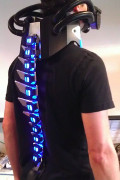|
Well it's time for a gear thread. So, who do you buy your stuff from? Who do you trust? What do you actually wear? What do you want to know? Feel free to tell me what should be in this first post And correct me if I'm wrong. I'll be adding to this post as people add good information. To start off, here's a short incomplete list. I'll be adding links to all the manufacturers as time allows. Cheap Gear: https://www.motorcyclecloseouts.com https://www.motorcycle-superstore.com (closeouts rock..) https://www.newenough.com Manufacturers: Fieldsheer: Textile, Leather, Gloves AGV: Helmets, Textile, Leahter Arai: Helmets Icon: Helmets, Textile, Leather, Boots, Gloves Sidi: Boots, Leather Shift: Boots, Leather, Textile, Gloves Daniese: Leather, Gloves Joe Rocket: Boots, Leather, Textile, Gloves HJC: Helmets KomodoGear: Leather, Textile KomodoGear Firstgear: Textile, Leather https://www.firstgear-usa.com Vanson: Duh.. Leather https://www.vansonleathers.com Alpinstars: Boots, Gloves, Textile, Leather https://www.alpinestars.com Tourmaster: Boots, Gloves, Textile, Leather https://www.tourmaster.com Aerostitch: Textile Masters. https://www.aerostitch.com FAQ: Q: Is leather safer? A: Yes. Textile however is not suicide. Leather is the best we've got, and if you want the best protection without considering any other factors, leather is what you wear. Q: Why can't I wear my normal leather jacket? A: Well you can wear it riding. Just don't pretend to think it will protect you. Riding leathers are made from 1-2mm leather. Some seriously thick stuff, that is also tanned for strength. Your average fashion leather jacket is half grain or less, some fraction of a mm thick, and contains no armor, no facilities for cooling, no design features to prevent it from riding up, no way to attach it to pants... And I could go on. Q: What does Snell and DOT mean? What's it mean to me? A: Snell and DOT stickers on a helmet mean they've gone through an approval process. DOT is mandatory for any street helmet. If your helmet doesn't have a DOT sticker on it, it's not a helmet. Snell is a voluntary testing standard for helmets. It's required by most racing bodies. It is a much more stringent test, and it costs the MFG a signifigant amount of money to retain the right to put that sticker on a helmet. The stickers can be taken away at any time.. so MFGs are apt to do everything they can to keep this approval. How to fit a helmet: This is not something you can do without going to a motorcycle shop. Please, please buy the helmet from the shop you try it on at. We need to keep the local buisnesses around. Go find the display helmets, try one on. Don't strap it on yet. Shake your head violently. If the helmet moves in relation to your face, it's to lose. Go try the next size down. The helmet will feel quite snug, do yourself a favor, and wear the helmet for five or ten minutes if you can. If you don't feel any hot spots, or sore spots you probally have a good helmet on. All helmets are NOT made alike. Each manufacturer has their own shaped head that they use. (or several heads) So if one MFG's helmet fits but leaves your forhead hurting, another may not. Try a few on, see what feels right. Now you may not find a "perfect" helmet. Remember you can do a little sculpting of the inside of the helmet. If you have one particular spot that's giving you a problem, take a spoon and rub the spoon against the inside of the hemlet where you're having the sore spot. That will depress the foam a little and alievate the issue. (it's likely only to need 1/16" or less, so you're not exactly hurting the safety of your helmet, and if it's more comfortable, you're more likely to wear it!) Fitting Leathers: Leathers should be snug. If they can move around signifigantly their protection is reduced. When you chose leathers for street riding you should also consider a little extra room for a long sleeve shirt or long underwear. Nothing off the rack fits me, so I'll need to defer to others here who can for further advice. Update: goddamnedtwisto posted:Okay peeps I've (as always) seriously overshot on this, but still feel like there's quite a bit more that could go in - please take a read and let me know if i've made any major cockups or omissions. I feel like I should probably put in a few more images if only to break up the wall of text a bit. Somebody fucked around with this message at 14:37 on Aug 27, 2020 |
|
|
|

|
| # ? Apr 19, 2024 12:19 |
|
I don't ride, but how about NewEnough for cheap gear?
|
|
|
|
Might as well post this here too While we're talking about them, does anyone have an experience with the Icon Accelerant leather jacket? I currently have a textile that I love, but my brother is going to start riding, and I figured I'd give it to him. http://tinyurl.com/ys9r9q
|
|
|
|
In to pimp KomodoGear, as it's some of the best stuff I've ever owned. Also, their custom-fit pricing is very nice.
|
|
|
|
RealDealNamowicz posted:Might as well post this here too Nerobro, you can add FirstGear, Vanson, Alpinestars, and Tour Master/Cortech to the list. Here's the URLs: http://www.firstgear-usa.com/ http://www.vansonleathers.com/ http://www.alpinestars.com/ http://www.tourmaster.com/ Forgot Aerostich too: http://www.aerostich.com/
|
|
|
|
What leather jacket would ya'll recommend for an old Shadow? Something perforated, preferably, since it regularly tops 100degrees in August. And it's Houston, so it's way humid. Have any of you had hot weather time with a perf leather jacket and want to share the experience? Or something that's vented, like FirstGear's Honcho...doesn't seem like it would be enough in high heat, but I like the design. And most of my riding is downtown stop and go traffic. Most of the perf ones I like are designed with CBR's and other sport bikes in mind, but might end up getting one like that anyway. Also, it should have pockets for armor.
|
|
|
|
Wow, maybe I'll forgo the leather, I just found a sweet Cortech textile jacket.
|
|
|
|
My leather gear is Dainese and my textile/wet weather stuff is Frank Thomas. http://www.frank-thomas.co.uk/ Frank Thomas gear is only available through Cycle Gear in the US.
|
|
|
|
Eeeexcellent NeroBro Perhaps goons can help me with my little conundrum then. Do I buy a proper 2 piece leather suit (I dont want a 1 piece suit) or do I buy a jacket now and pants later, given the fact that I will probably only wear the pants once or twice a year for trackdays etc. What is the consensus of the quality of Teknic's leathers?
|
|
|
|
Road_Warrior posted:Do I buy a proper 2 piece leather suit (I dont want a 1 piece suit) or do I buy a jacket now and pants later, given the fact that I will probably only wear the pants once or twice a year for trackdays etc.
|
|
|
|
I recently got a new fieldsheer jacket from ridegear.com - their blowout section has some very reasonable pricing. I would just like to point out to everyone that jeans apparently have less abrasion resistance than skin. I don't always ride with proper riding pants, but when I'm wearing jeans I figure I have essentially no leg protection. The couple of times I crashed at the track I did the majority of damage to my hip area on my leathers. To be honest if I had to choose between crashing with leather pants or crashing with a leather jacket I'd choose the pants.
|
|
|
|
I have BMW textile gear. I don't own a car, so I ride year round. I also spent all my money on my bike (F650GS), so I only had money for one set of gear, not summer leathers and winter textiles. I have the Commuter 2 Jacket, which is 500 Denier Cordura with shoulder, elbow and back pads. It also has 3 vents on each side. It has a zip-in waterproof liner. It's really nice in summer with the zips open, and in winter it's nice with the liner. I've ridden in the jacket in a thunder and lightning storm with torrential rain, and although the outer jacket was moist when I was through, the inner liner remained dry. I also have washed in in Nik-Wax Direct Wash-in, which has improved the water-proofing of the outer jacket. Overall, I really like this jacket. For pants I have the BMW City pants. I'm slightly dissapointed with these pants. Although they were waterproof when I got them, that wore out after a few washes, and the Nik-Wax doesn't seem to wash it back in. It gets water-resistant, but not proof again, due largely I think to the fact that they're partially denim, not all Cordura. They're very hot in the summer. They also have knee and hip pads. The pants also don't fit that well over other pants, which makes me less likely to wear them, something I'd like to improve upon with my next pants. I have two sets of boots. One set is BMW, they're the cheapest ones, that are designed to look like street shoes. They're really comfy in Summer and have good grip. They're also really comfy to walk around in. I've walked around zoos and towns and beaches and never had sore feet. But when it started raining I had to get different ones. Alpinestars makes good boots with a Gore-Tex liner. They're also pretty comfy on the bike, but impossible to walk in, the upper velcro comes loose. For summer gloves I have the Held Steve kangaroo skin gloves. The only problem I have with these gloves is that the middle finger on both gloves came unstitched after I accidentally got rained on in them. I have to keep restitching them. My winter gloves I bought for emergency purposes when it poured on me the next day after that and I can't really recommend them. They take away alot of feeling at the grips, and I know that's pretty standard but I'm sure there's something better out there. For my helmet, I have a Schuberth C2. I have a wierd shaped head, and it fits pretty well. I look like a complete loving dork when the face is open, but it's got really good venting, even in the rain, and the flip down sunshade is executed very well too. I have to drive through a tunnel twice a day, so being able to have sunshade and then flip it up in the tunnel is really cool. I really like the BMW gear, and will probably continue to buy it (if I can afford it). Alot of my purchases have been purchases of necessity rather than research, so I have a feeling I'll be even happier with my next set in a few years. It's well designed, durable, and even though I haven't put my bike down (yet?), I feel very secure in it (if only for the one fall it'll survive through). Most of my stuff, except for the winter gloves, was pretty expensive, I'll admit. I only make about 34k a year (and live in the SF Bay Area), so I'm not the kind of guy who can just go out and buy pricey gear cause I can. But when it comes to safety on the road, I figured it was all worth the investment.
|
|
|
|
bung posted:My leather gear is Dainese and my textile/wet weather stuff is Frank Thomas. I have a full Frank Thomas 1PC racing suit, purchased from Cycle Gear. Protip: They are a low-cost Dainese line. FT are more general in sizes and fitment, and while the crash protection is just about as good, some of the amenities of the suit are not Dainese - nice. If you can't afford a $1800 race suit, the FT gear will work just fine for you at $699. Slap your velcro pucks of choice on the knees, and go drag one with confidence 
R-Type fucked around with this message at 07:08 on Mar 25, 2007 |
|
|
|
EDIT =/ QUOTE Mod please delete this poo poo, sorry
|
|
|
|
Another big BMW gear fan here. I used to go for the cheaper middle of the road products, like Tour Master, Alpenstars and Fieldsheer, the gear was nice and held up ok with a few lose threads here and waterproof being a myth. I picked up an F650 GS Dakar a couple of months ago and it came with a BMW Rallye 2 suit that was a bit too big for me. At first I thought of it as a nice extra chunk of change that'd I'd sell and use to buy some extra tires or something. After a 1200 mile ride home in freezing early February temps I'm convinced, it's the nicest gear I've ever worn. The suit was too big for me so I sold it and bought a new Rallye 2 Pro jacket and I'll likely soon buy a set of Dakar pants from Rev'it (many claim their gear is right up there in quality with BMW) or a set of BMW's Savanna II pants. The goretex liner in the pants is as nice as some of my North Face and Mountain Hardware clothing that I use for mountaineering. The logical and useful vent placement as well as the adjustable contoured armor makes the jacket feel more like a fitted suit jacket than a bunch of material that I'm stuffing between me and asphalt. I've never felt a drop of rain, and with the wind and water proof liner in I feel like I'm wearing an environment suit. It's expensive stuff, crazy expensive as a matter of fact, I could have bought a new business suit and taken my girlfriend out for a full dinner at the nicest restaurant in town for less. I don't regret the purchase for a second. My other gear consists of Tour Master Apex II pants which I like just fine for pavement non-rainy riding. The mesh liner inside them is starting to tear in a few spots after ~40K miles. I'll likely wear the new pants more often once I get them. I have an Icon Motorhead leather jacket which would be great if I lived in Southern California, here in Denver I need to pair it with a heated liner in all seasons other than summer. I like the fit and the vents are ok but nothing in comparison to my Rallye 2 Pro. My HJC AC-12 Carbon is a nice helmet if the visor didn't have a few distortions and if it was a little quieter I'd say it was perfect, but as is it's a nice looking very light helmet. I expect my next one will be an Arai to see what all the fuss is about, but I'm also leaning more towards Shark too. I wish I had a Shoei shaped head so I could use their kick rear end visors and retention system. I'm still bothered by the Arai side pucks that make changing visors a pain. I've been really happy with my Alpinstars SP II gloves and my Tour Master Winter Elite 2s. The Winter Elites are truely water proof and have served me well down to 9F. The SP-IIs are a little thin but I like the feel of the controls with them on. I had a set of GPS-3 boots which were great and I logged ~30K miles in them, after that they were pretty worn and I've passed them onto Xaine. I now have a set of Garene Explorers which are black and don't have any velcro, they're lacking in ankle support but are easy to hike in. I also have a set of BMW GS 1 boots, I like these but I can't wear them indoors as it sounds like I'm walking on a bed of ducks with all the squeaking and quacking that the plastic does. Their protection is second to none though. My faviorite piece of gear still remains my heated liner, it lets me ride year round and keeps my focus on the road rather than on the temperature. It has never dissapointed me and after ~25K miles it still works as well as the day I bought it. I'll be happy to answer any questions about the gear. For those that have the Shoei X-11 and have tried Arai helmets how does the fit compare? I love Shoei's stuff but I have a very Arai shaped head, (the Quantum feels like angel hands cupping my face.) For those that have the Arai helmets, how often do you change visors? After a while can you do it in the dark by the roadside?
|
|
|
|
What is everyone's opinion of knee armor worn under regular jeans? If I'm driving less than three miles to work, it just doesn't seem worth it to put on my leather trousers, drive 15 minutes, then take them off and change into my regular jeans. Should I just shut up and deal, or does the knee armor sound ok for short distances? edit: something like these: http://tinyurl.com/356l5s
|
|
|
|
Haha, I was just telling my mom how it's gonna get hot riding around in the leathers and she was all, "then why wear it?" I was, "because I don't want to get hurt when I fall." She said, "then don't fall." Oh, mom.
|
|
|
|
teknicolor posted:What is everyone's opinion of knee armor worn under regular jeans? If I'm driving less than three miles to work, it just doesn't seem worth it to put on my leather trousers, drive 15 minutes, then take them off and change into my regular jeans. Should I just shut up and deal, or does the knee armor sound ok for short distances? That's still only half the protection you need for your knees. Impact protection and abrasion protection is required and jeans provide neither. Those pads only provide impact protection on your knees.
|
|
|
|
PlasticSun posted:
Changing Arai visors, for me at least, requires every curse word I know and occasionally the sacrifice of an innocent's blood. Sometimes they go right in. Usually, they don't. The Arai I bought last year even came with a CD-ROM instructional video, it's THAT unintuitive. I swear, I must have changed out visors on both my old Arai and new a hundred times. It doesn't seem to get any easier.
|
|
|
|
I have an Arai, and I just don't bother with changing visors. I wear glasses anyway, so if it's bright I just clip on my shades, and keep the visor clear. Seems like you could do that with sunglasses as well if it's really that much trouble. Also, I've been looking for a good leather jacket for a while now. I want one that's neither harleyish, nor one of those carnival colored crotchrocket jackets. I went into a local leather shop the other day, and found one that I really liked, but I'm not sure it it's going to offer the protection of a name brand jacket. It was obviously meant for riding, with a zip out inner liner and vents. The material seemed pretty thick, but how can I tell if it's going to be as safe? Lastly, what's preforated leather? My guess is it has tiny holes, but why?
|
|
|
|
I can probably change the shield on my Arai in under 15 seconds. The first few times I thought I was going to break the drat thing though. My Suomy on the other hand is a bit weird. You either need a key or a screwdriver to pop the sides off and then swap the shield out. But that helmet fits soooo nicely.
|
|
|
|
On the whole Icon thing: I have the Daytona jacket and its very sturdy. The shoulder and forearm armor are nice, although the back pad is junk. Not sure about their other gear. Can anyone recommend some gloves? I've been looking at A* and Held. This is just for street use. The Joe Rocket shorties I have are pretty cheap, I'd just like something better. Tremblay fucked around with this message at 23:21 on Mar 25, 2007 |
|
|
|
What do you guys think of RST leathers? I'm thinking of getting an RST SRT leather jacket with a view to buying the trousers at a later date (click for bigger): In an ideal world, where I had £220, I'd get this gorgeous jacket from Hein Gericke: 
|
|
|
|
I also bought some new knee pucks yesterday. The ones that came with my pants weren't that great. These new ones are a bit bigger and will make contact with the ground a little sooner and last longer. The new ones are also ceramic where the old ones were plastic. Got them for $35 as a local shop that just opened had all motorcycle apparel and parts for cost +10%.
|
|
|
|
Skier posted:That's still only half the protection you need for your knees. Impact protection and abrasion protection is required and jeans provide neither. Those pads only provide impact protection on your knees. Wait, you're telling me that thick composite/whatever plastic won't be better for abrasion resistance than leather? I think I would rather have my knees dragging on concrete in those than a set of leather pants.
|
|
|
|
Leroy Diplowski posted:I went into a local leather shop the other day, and found one that I really liked, but I'm not sure it it's going to offer the protection of a name brand jacket. It was obviously meant for riding, with a zip out inner liner and vents. The material seemed pretty thick, but how can I tell if it's going to be as safe? Did the jacket have armor at all? Perforated leather has holes to allow wind to get in to keep you cool in the summer. Sounds nice to me and I may look into getting some myself later this year. Tremblay posted:Can anyone recommend some gloves? I've been looking at A* and Held. This is just for street use. The Joe Rocket shorties I have are pretty cheap, I'd just like something better. I've got these that I like a lot: http://www.newenough.com/gloves/street_short_cuff/cortech_by_tour_master/accelerator_motorcycle_gloves.html I bought them a little tight, and now they are perfectly formed.
|
|
|
|
R-Type posted:...Frank Thomas...Protip: They are a low-cost Dainese line. PlasticSun posted:For those that have the Arai helmets, how often do you change visors? After a while can you do it in the dark by the roadside? Neck Tooth posted:Changing Arai visors, for me at least, requires every curse word I know and occasionally the sacrifice of an innocent's blood. orinth posted:My Suomy on the other hand is a bit weird. You either need a key or a screwdriver to pop the sides off and then swap the shield out. But that helmet fits soooo nicely.
|
|
|
|
I have two questions: Are mesh pants really going to do much more than jeans for me? Would they be comfortable to wear over shorts? They don't look all that sturdy but if mesh pants +shorts is better than just plain jeans which is what I wear now I'll do it for the shorts. Edit: Obviously I am talking about just driving around town at low speeds, not racing or anything. 2. Can you get replacement liners for First Gear jackets? Somehow my liner disappeared and I can't find it anywhere. OMGWTFWALLHACK fucked around with this message at 03:31 on Mar 26, 2007 |
|
|
|
Leroy Diplowski posted:
ICON is making a ton of black jackets.     
|
|
|
|
PlasticSun posted:For those that have the Arai helmets, how often do you change visors? After a while can you do it in the dark by the roadside? http://www.youtube.com/watch?v=8IfuA9b_75g It is very easy once you have done it a few times, but goddamn the first 10 or so tries at getting the visor to latch into the pods is  I emailed KomodoGear about that "Classic" jacket of theirs - turns out it is perforated, so I'll be putting in an order for one once I find a new bike. Bob Morales posted:ICON is making a ton of black jackets. ICON is the riced-out V6 Mustang of motorcycle gear - all show, no go Leroy Diplowski posted:Also, I've been looking for a good leather jacket for a while now. I want one that's neither harleyish, nor one of those carnival colored crotchrocket jackets. I went into a local leather shop the other day, and found one that I really liked, but I'm not sure it it's going to offer the protection of a name brand jacket. It was obviously meant for riding, with a zip out inner liner and vents. The material seemed pretty thick, but how can I tell if it's going to be as safe? Check out newenough, kneedraggers, motorcyclecloseouts.com, ridegear, etc. FirstGear makes a few understated jackets; RevIT has a really nice one, the style is called "Moto". IMG here (not my host): http://www.autoserviciomotorista.com/images/productos/cuero/4005.jpg Jazzzzz fucked around with this message at 02:22 on Mar 26, 2007 |
|
|
|
RealDealNamowicz posted:Wait, you're telling me that thick composite/whatever plastic won't be better for abrasion resistance than leather? I think I would rather have my knees dragging on concrete in those than a set of leather pants. Negative, I'm telling you your knees aren't the only part of you grinding away at the pavement. Unless you're really talented. If you wear those under a pair of jeans, you gain very protection for the amount of effort.
|
|
|
|
teknicolor posted:What is everyone's opinion of knee armor worn under regular jeans? If I'm driving less than three miles to work, it just doesn't seem worth it to put on my leather trousers, drive 15 minutes, then take them off and change into my regular jeans. Should I just shut up and deal, or does the knee armor sound ok for short distances? Look into textile overpants.
|
|
|
|
OMGWTFWALLHACK posted:I have two questions: I don't know much about pants, but I have a leather and a mesh jacket. The mesh was fine in the summer until I got sick of wearing a sweatshirt in 70 degree weather and bought a leather jacket. The leather is so much nicer and feels much sturdier than the mesh. Right now, I'm thinking I would rather ride in the leather (it has removable panels for warmer weather) than the mesh, even in the heat. If I were you, I would look into perforated leather pants.
|
|
|
|
Skier posted:Negative, I'm telling you your knees aren't the only part of you grinding away at the pavement. Unless you're really talented. Ohhh I got what you were saying, thanks. This is the Cortech textile jacket I just bought (black) http://tinyurl.com/32mgqv
|
|
|
|
So can anyone give me some feedback on Teknic stuff, like their leather jackets and suits. I got my eye on a particular jacket but I don't want to buy any of their gear if it is like the stories I have heard about Icon's stuff.
|
|
|
|
Road_Warrior posted:So can anyone give me some feedback on Teknic stuff, like their leather jackets and suits. I got my eye on a particular jacket but I don't want to buy any of their gear if it is like the stories I have heard about Icon's stuff. Teknic is OK if you stay away from their lower end stuff (Lightning/Chicane) - the stitching isn't so great.
|
|
|
|
Jazzzzz posted:Teknic is OK if you stay away from their lower end stuff (Lightning/Chicane) - the stitching isn't so great. I have a chicane 2 piece and it's not bad except for the crap knee pucks (see 10 posts above). I really like the jacket as well.
|
|
|
|
teknicolor posted:What is everyone's opinion of knee armor worn under regular jeans? If I'm driving less than three miles to work, it just doesn't seem worth it to put on my leather trousers, drive 15 minutes, then take them off and change into my regular jeans. Should I just shut up and deal, or does the knee armor sound ok for short distances? I was looking at doing this for my commute to school, since it's only a few minutes ride and I don't particularly want to be walking around in campus in full leathers. What I heard on some other bike message boards though was that after the initial impact unless it's directly straight on, the pads get absolutely wrenched around. For shits and giggles, I went by the local cyclegear and tried on a pair of the knee/shin armor they had and it wasn't strapped on nearly as tight as I'd like. Thinking about it now, for reference, when I slide tackle or similarly slip/fall when playing soccer my shinguards have often been twisted around, and they are very form fitting, under tight socks, and held in place with tight athletic tape. I really wouldn't have much faith in just a few velcro straps, especially when knee pads are notoriously loose fitting to allow for knee movement. I have a pair of mesh overpants being shipped right now that have full length zippers on them and armor in the knees/hips, so I should be able to put them on/take them off/roll them up in a few moments time.
|
|
|
|
Where are the Aerostich superfans in this thread?PlasticSun posted:For those that have the Arai helmets, how often do you change visors? After a while can you do it in the dark by the roadside? I'm enjoying my Scorpion EXO-700 helmet so far, but it certainly isn't as comfortable as my Arai. I attribute some of this to a hot spot on the forehead, but overall it's louder and not as nice. Of course, it was also literally half the price of my Quantum II.
|
|
|
|

|
| # ? Apr 19, 2024 12:19 |
|
Mapless posted:
I swear to sweet baby hay-soose that whenever I'm on a group ride and it's getting too sunny, I'll say, "Hold on for ten minutes while I figure this loving thing out, these visors drive me nuts!" And the visor change will happen in ten seconds. But sitting at home, saying, "Well, I'm going on that long ride tomorrow, I'll change my visor NOW so I don't have to do it in the morning!" that fucker'll take me five-ten minutes of cursing and crying. Mr. Arai hates me, that's the only answer. But goddamn, do I love his helmets anyway. Jazzzzz posted:http://www.youtube.com/watch?v=8IfuA9b_75g loving black magic. BLACK MAGIC. Ha, but I think my issue is that it really DOES feel like the visor/helmet's gonna break when you change them out. I just can't get used to bending a piece of (expensive) plastic like that without getting all worried. I'll go to a therapist, maybe that'll help. Neck Tooth fucked around with this message at 07:02 on Mar 26, 2007 |
|
|
































